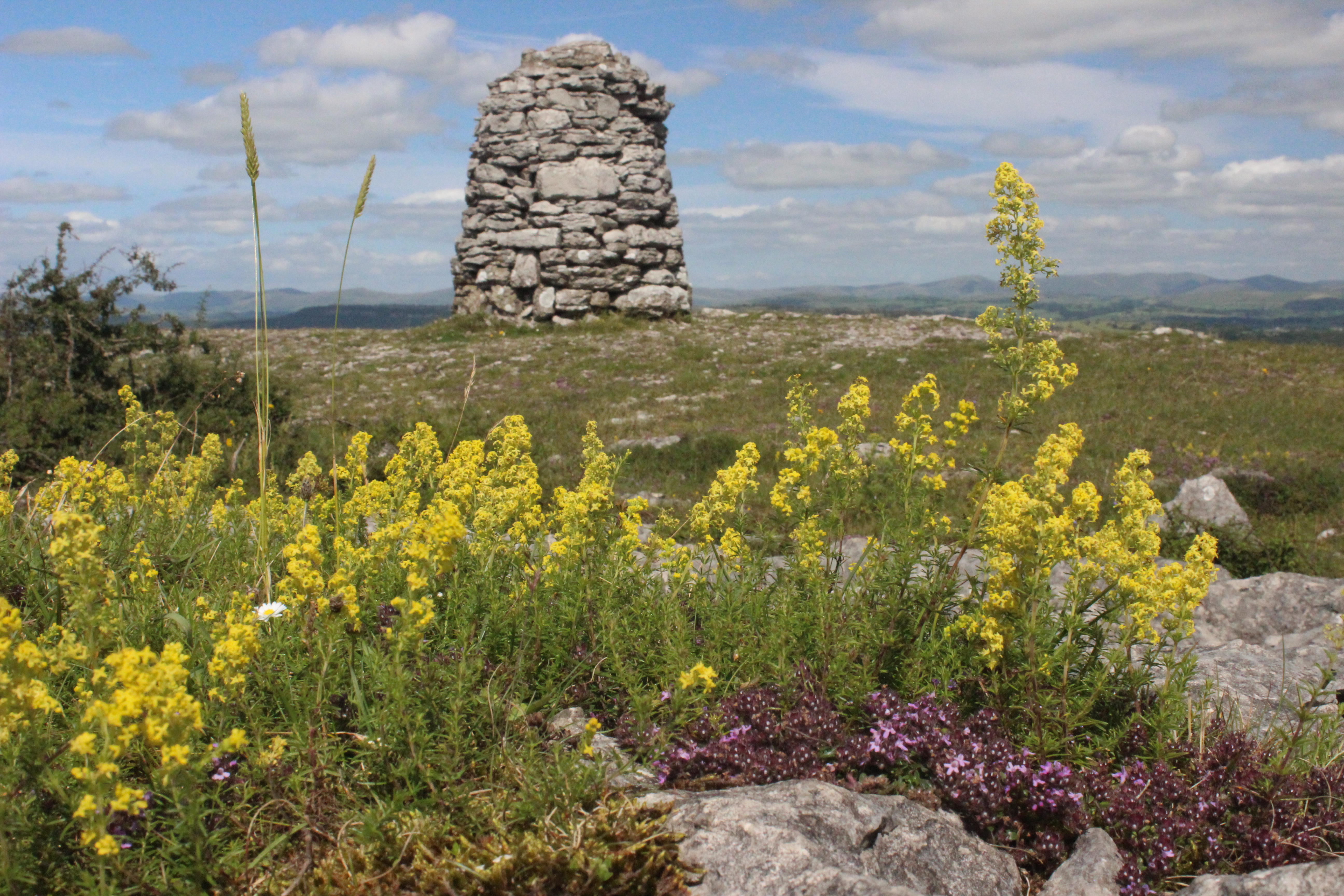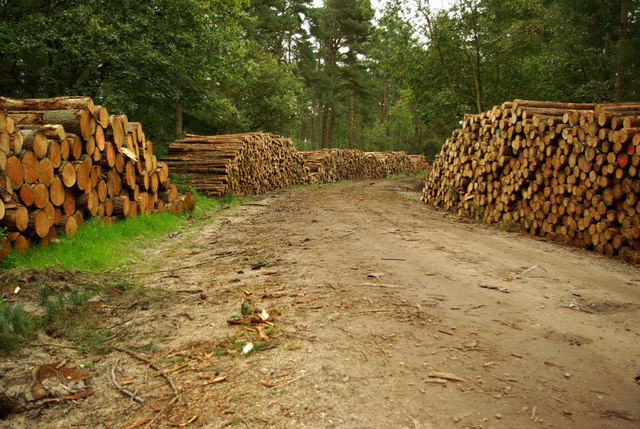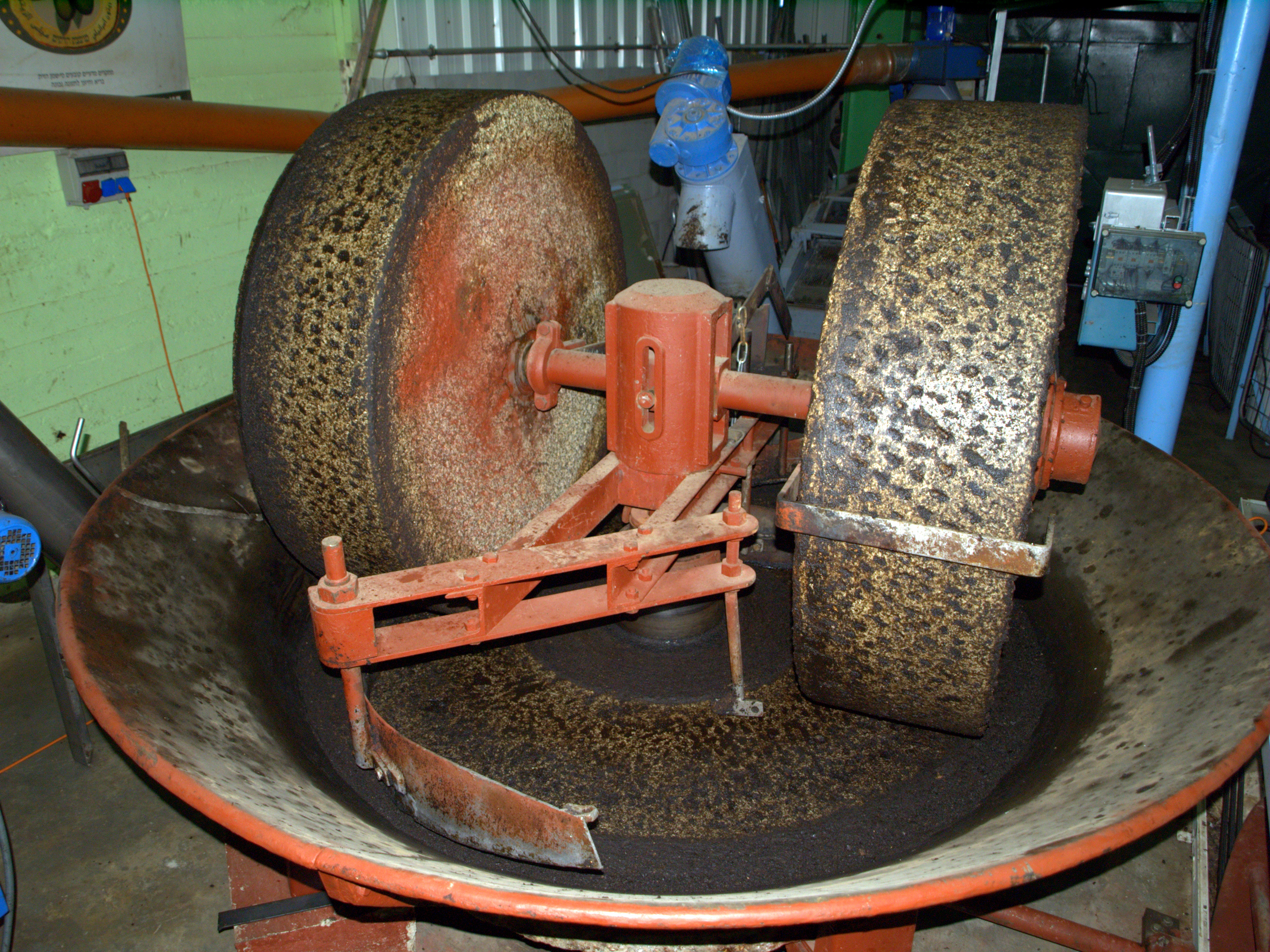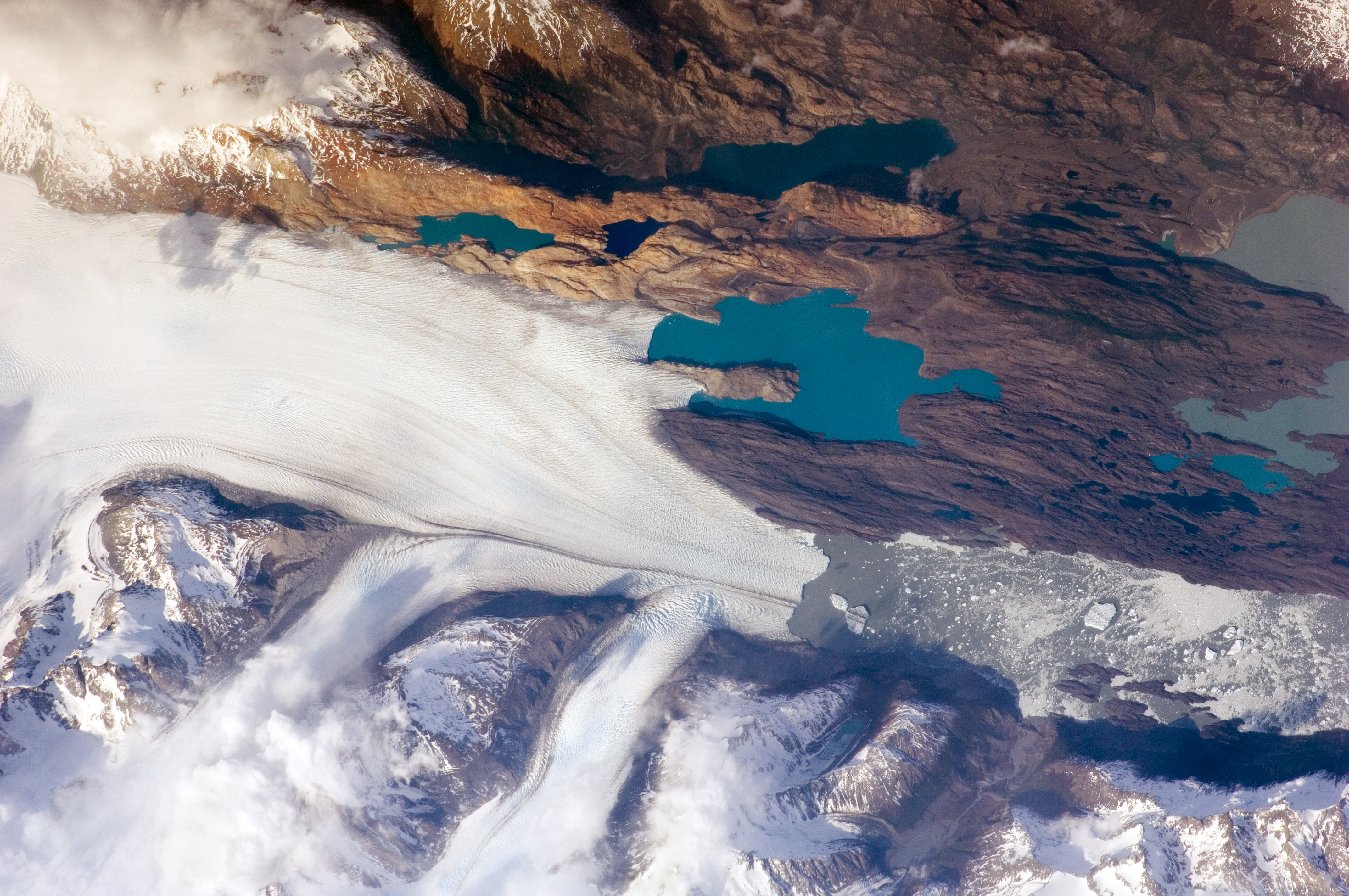|
Whitbarrow Scar
Whitbarrow is a hill in Cumbria, England. Designated a biological Site of Special Scientific Interest and national nature reserve, it forms part of the Morecambe Bay Pavements Special Area of Conservation due to its supporting some of the best European examples of natural limestone habitats. Also known as Whitbarrow Scar (though properly that term applies to the cliffs lining its western edge), the hill lies about south-west of Kendal, just north of the A590 road, close to the village of Witherslack. Part of the site is a local nature reserve called Whitbarrow Scar. It is a mixture of woodland, grassland and limestone pavement. The hill is prominent from the A590 road with its steep limestone cliffs, laid down in the Carboniferous period some 350 million years ago. The main cliff faces are made up of rocks known as Dalton Beds, above which are Urswick Limestones, of which the limestone pavement (here and elsewhere around Morecambe Bay, including Hutton Roof Crags) has been ... [...More Info...] [...Related Items...] OR: [Wikipedia] [Google] [Baidu] |
Oversands School
Oversands School (formerly Witherslack Hall School) is an independent special school with specialist SEN status situated in the village of Witherslack near Grange-over-Sands, Cumbria, England. It was opened in 1973 as a residential and day school for boys aged 11–19 with special educational needs, including complex learning, communication, behavioural, emotional and social difficulties. The school has now been renamed to Oversands School and is a coeducational school for pupils aged 8 to 19. Witherslack Hall The school's central building, Witherslack Hall, was built in 1874 by Lancaster architects Paley and Austin and is recorded in the National Heritage List for England as a designated Grade II listed building. It gave its name to a steam locomotive in the GWR Modified Hall Class, 6990 Witherslack Hall. See also *Listed buildings in Witherslack *List of non-ecclesiastical works by Paley and Austin Paley and Austin were the surnames of two architects working fro ... [...More Info...] [...Related Items...] OR: [Wikipedia] [Google] [Baidu] |
Grassland
A grassland is an area where the vegetation is dominated by grasses (Poaceae). However, sedge (Cyperaceae) and rush (Juncaceae) can also be found along with variable proportions of legumes, like clover, and other herbs. Grasslands occur naturally on all continents except Antarctica and are found in most ecoregions of the Earth. Furthermore, grasslands are one of the largest biomes on earth and dominate the landscape worldwide. There are different types of grasslands: natural grasslands, semi-natural grasslands, and agricultural grasslands. They cover 31–69% of the Earth's land area. Definitions Included among the variety of definitions for grasslands are: * "...any plant community, including harvested forages, in which grasses and/or legumes make up the dominant vegetation." * "...terrestrial ecosystems dominated by herbaceous and shrub vegetation, and maintained by fire, grazing, drought and/or freezing temperatures." (Pilot Assessment of Global Ecosystems, 2000) * "A ... [...More Info...] [...Related Items...] OR: [Wikipedia] [Google] [Baidu] |
Cairn On Whitbarrow, Cumbria
A cairn is a man-made pile (or stack) of stones raised for a purpose, usually as a marker or as a burial mound. The word ''cairn'' comes from the gd, càrn (plural ). Cairns have been and are used for a broad variety of purposes. In prehistoric times, they were raised as markers, as memorials and as burial monuments (some of which contained chambers). In modern times, cairns are often raised as landmarks, especially to mark the summits of mountains. Cairns are also used as trail markers. They vary in size from small stone markers to entire artificial hills, and in complexity from loose conical rock piles to elaborate megalithic structures. Cairns may be painted or otherwise decorated, whether for increased visibility or for religious reasons. A variant is the inuksuk (plural inuksuit), used by the Inuit and other peoples of the Arctic region of North America. History Europe The building of cairns for various purposes goes back into prehistory in Eurasia, ranging in s ... [...More Info...] [...Related Items...] OR: [Wikipedia] [Google] [Baidu] |
The Outlying Fells Of Lakeland
''The Outlying Fells of Lakeland'' is a 1974 book written by Alfred Wainwright dealing with hills in and around the Lake District of England. It differs from Wainwright's '' Pictorial Guides'' in that each of its 56 chapters describes a walk, sometimes taking in several summits, rather than a single fell. This has caused some confusion on the part of authors attempting to prepare a definitive list of peaks. The Outlying Fells do not form part of the 214 hills generally accepted as making up the Wainwrights, but they are included in Category 2B of the ''Hill Walkers' Register'' maintained by the Long Distance Walkers Association. The book The first edition was published in 1974 by ''The Westmorland Gazette''. It was republished by Michael Joseph in 1992 () and a second edition, revised by Chris Jesty, was published by the Wainwright Society in 2020 (). The first edition is uniform with the seven volumes of Wainwright's ''Pictorial Guides'', with a yellow band at head and fo ... [...More Info...] [...Related Items...] OR: [Wikipedia] [Google] [Baidu] |
Alfred Wainwright
Alfred Wainwright MBE (17 January 1907 – 20 January 1991), who preferred to be known as A. Wainwright or A.W., was a British fellwalker, guidebook author and illustrator. His seven-volume ''Pictorial Guide to the Lakeland Fells'', published between 1955 and 1966 and consisting entirely of reproductions of his manuscript, has become the standard reference work to 214 of the fells of the English Lake District. Among his 40-odd other books is the first guide to the Coast to Coast Walk, a 182-mile long-distance footpath devised by Wainwright which remains popular today. Life Alfred Wainwright was born in Blackburn, Lancashire, into a family which was relatively poor, mostly because of his stonemason father's alcoholism. He did very well at school (first in nearly every subject) although he left at the age of 13. While most of his classmates were obliged to find employment in the local mills, Wainwright started work as an office boy in Blackburn Borough Engineer's Department. He ... [...More Info...] [...Related Items...] OR: [Wikipedia] [Google] [Baidu] |
Forestry Commission
The Forestry Commission is a non-ministerial government department responsible for the management of publicly owned forests and the regulation of both public and private forestry in England. The Forestry Commission was previously also responsible for Forestry in Wales and Scotland. However, on 1 April 2013, Forestry Commission Wales merged with other agencies to become Natural Resources Wales, whilst two new bodies (Forestry and Land Scotland and Scottish Forestry) were established in Scotland on 1 April 2019. The Forestry Commission was established in 1919 to expand Britain's forests and woodland, which had been severely depleted during the First World War. The Commission bought large amounts of agricultural land on behalf of the state, eventually becoming the largest manager of land in Britain. Today, the Forestry Commission is divided into three divisions: Forestry England, Forestry Commission and Forest Research. Over time the purpose of the Commission broadened to includ ... [...More Info...] [...Related Items...] OR: [Wikipedia] [Google] [Baidu] |
Cumbria Wildlife Trust
Cumbria Wildlife Trust is a wildlife trust covering the county of Cumbria, England. It runs more than 40 nature reserves, and aims to broaden the awareness and knowledge of the wildlife in the county. History The trust was established in 1962 as the Lake District Naturalists' Trust. It changed its name to the Cumbria Trust for Nature Conservation in 1974, when the county of Cumbria was created. Its headquarters are near Kendal, at the edge of the Lake District National Park. Most of the reserves, which include peat bogs (Witherslack Mosses), limestone pavements (Hutton Roof Crags), ancient woodlands and coastal sites (South Walney), are outside the national park. Recent acquisitions include Craggy Wood at Staveley. Activities The trust runs educational programmes for visitors, suitable for all ages, and welcomes the involvement of volunteers. It also campaigns regionally and nationally on a range of wildlife issues. In recent years it has been involved with hay meadows (via the ... [...More Info...] [...Related Items...] OR: [Wikipedia] [Google] [Baidu] |
Lake District National Park Authority
The Lake District National Park is a national park in North West England that includes all of the central Lake District, though the town of Kendal, some coastal areas, and the Lakeland Peninsulas are outside the park boundary. The area was designated a national park on 9 May 1951 (less than a month after the first UK national park designation — the Peak District). It retained its original boundaries until 2016 when it was extended by 3% in the direction of the Yorkshire Dales National Park to incorporate areas such as land of high landscape value in the Lune Valley. It is the most visited national park in the United Kingdom with 16.4 million visitors per year and more than 24 million visitor-days per year, the largest of the thirteen national parks in England and Wales, and the second largest in the UK after the Cairngorms National Park. Its aim is to protect the landscape by restricting unwelcome change by industry or commerce. Most of the land in the park is ... [...More Info...] [...Related Items...] OR: [Wikipedia] [Google] [Baidu] |
Millstone
Millstones or mill stones are stones used in gristmills, for grinding wheat or other grains. They are sometimes referred to as grindstones or grinding stones. Millstones come in pairs: a convex stationary base known as the ''bedstone'' and a concave ''runner stone'' that rotates. The movement of the runner on top of the bedstone creates a "scissoring" action that grinds grain trapped between the stones. Millstones are constructed so that their shape and configuration help to channel ground flour to the outer edges of the mechanism for collection. The runner stone is supported by a cross-shaped metal piece (millrind or rynd) fixed to a "mace head" topping the main shaft or spindle leading to the driving mechanism of the mill (wind, water (including tide) or other means). History The earliest evidence for stones used to grind food is found in northern Australia, at the Madjedbebe rock shelter in Arnhem Land, dating back around 60,000 years. Grinding stones or grindston ... [...More Info...] [...Related Items...] OR: [Wikipedia] [Google] [Baidu] |
Glacial Erratic
A glacial erratic is glacially deposited rock differing from the type of rock native to the area in which it rests. Erratics, which take their name from the Latin word ' ("to wander"), are carried by glacial ice, often over distances of hundreds of kilometres. Erratics can range in size from pebbles to large boulders such as Big Rock () in Alberta. Geologists identify erratics by studying the rocks surrounding the position of the erratic and the composition of the erratic itself. Erratics are significant because: *They can be transported by glaciers, and they are thereby one of a series of indicators which mark the path of prehistoric glacier movement. Their lithographic origin can be traced to the parent bedrock, allowing for confirmation of the ice flow route. *They can be transported by ice rafting. This allows quantification of the extent of glacial flooding resulting from ice dam failure which release the waters stored in proglacial lakes such as Lake Missoula. Erratics ... [...More Info...] [...Related Items...] OR: [Wikipedia] [Google] [Baidu] |
Ice Age
An ice age is a long period of reduction in the temperature of Earth's surface and atmosphere, resulting in the presence or expansion of continental and polar ice sheets and alpine glaciers. Earth's climate alternates between ice ages and greenhouse periods, during which there are no glaciers on the planet. Earth is currently in the Quaternary glaciation. Individual pulses of cold climate within an ice age are termed ''glacial periods'' (or, alternatively, ''glacials, glaciations, glacial stages, stadials, stades'', or colloquially, ''ice ages''), and intermittent warm periods within an ice age are called '' interglacials'' or ''interstadials''. In glaciology, ''ice age'' implies the presence of extensive ice sheets in both northern and southern hemispheres. By this definition, Earth is currently in an interglacial period—the Holocene. The amount of anthropogenic greenhouse gases emitted into Earth's oceans and atmosphere is predicted to prevent the next glacial period for th ... [...More Info...] [...Related Items...] OR: [Wikipedia] [Google] [Baidu] |
Hutton Roof Crags
Hutton Roof Crags is a hill in south-eastern Cumbria in north-west England, located near to the village of Hutton Roof. It has extensive areas of limestone pavement as well as grassland and woodland. The hill forms the Hutton Roof Crags Site of Special Scientific Interest and is part of the Morecambe Bay Pavements Special Area of Conservation. A significant proportion of the UK's of limestone pavement is to be found on Hutton Roof Crags and the neighbouring Farleton Knott. Although part of the hill is grass grazed by sheep, and part is forested, much remains open common land, and it is here that most of the limestone pavement is to be found. However, much has been removed over the years for many purposes including building, agricultural fertiliser, and production of millstones, but is now protected by law and it is an offence to remove any. The limestone is over thick, and was laid down during the Carboniferous period some 350 million years ago. The limestone pavements her ... [...More Info...] [...Related Items...] OR: [Wikipedia] [Google] [Baidu] |








